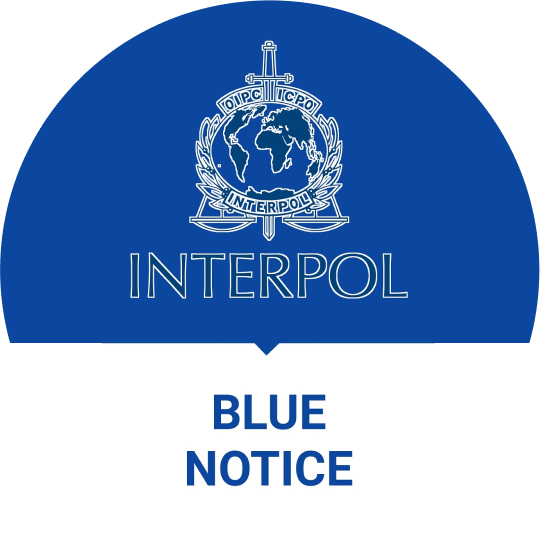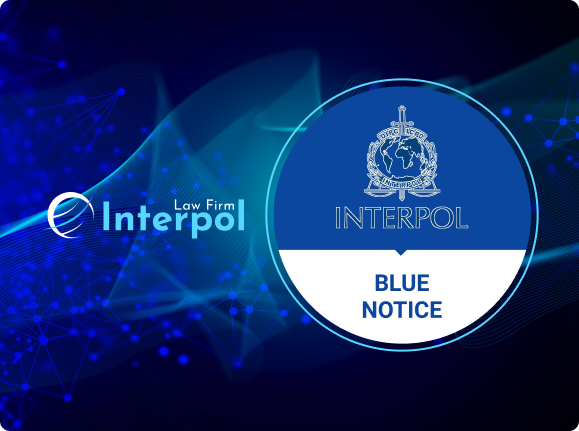
Interpol Blue Notice
Interpol blue notices are issued to gather information on individuals suspected of involvement in a crime or possessing crime-related knowledge. These notices help in identifying the suspect, their criminal activities, or whereabouts, aiding Interpol and authorities in tracking and investigating. For example, a Blue Notice might be requested to obtain data on a citizen suspected of complicity in crimes.

An INTERPOL Blue Notice is one of the most frequently utilized notices by law enforcement agencies, following Red Notices and Diffusion Notices. The Blue Notice plays a crucial role in international police cooperation, enabling INTERPOL member countries to locate and track individuals wanted for committing crimes. However, it is not uncommon for some countries to misuse Blue Notices, deploying them for purposes that do not align with INTERPOL’s standards and regulations. Consequently, it is essential to have an experienced INTERPOL lawyer to protect your rights in a timely and effective manner.

What is an INTERPOL Blue Notice?
Also known as the “enquiry notice”, the Interpol Blue notice refers to an alert circulated to help police and law enforcement agencies in member countries share critical information about a person’s criminal activities. As such, Interpol Blue notices are published for the following purposes:

- To obtain critical crime-related information on a person of interest in a criminal investigation, notably war crimes, genocide, and other transnational crimes.
- To seek the location of a person of interest in a criminal investigation.
- To identify a person of interest in a criminal investigation.
The subject of a blue notice is a person who has been convicted or charged, or who is a suspect, a witness, or a victim. For example, if the crime was committed in different jurisdictions, it is obvious that the victims may be in different countries.
For investigative purposes, an INTERPOL Blue Notice can be used to seek persons wanted for crimes or identify all the wanted persons or victims of a crime. The Blue Notice can also be used to obtain additional information about the person’s possible criminal history in another country, type of activity and place of residence, family, and any other information that can be used for investigative purposes.
How an INTERPOL Blue Notice is Issued?
The process of issuing an INTERPOL Blue Notice begins when a member state submits a request to INTERPOL’s General Secretariat. This request must include all relevant information about the missing person’s identity and the nature of the criminal charges or investigation.
Upon receiving the request, the General Secretariat reviews the information to ensure it complies with INTERPOL’s rules. If the request is approved, a new international alert notice is created and distributed to member countries through INTERPOL’s national central and databases.
Blue Notices can also be requested by the International Criminal Court (ICC) or other International Criminal Tribunals seeking a person wanted for criminal activities or possessing information on ongoing investigations. Additionally, the United Nations can request this notice to assist with sanctions from the Security Council Sanctions Committees.
INTERPOL Red Notice vs. Blue Notice

The primary difference between a Blue Notice and a Red Notice or Diffusion Notice is that a Blue Notice does not provide for the apprehension of individuals for extradition purposes. Additionally, a Blue Notice does not require an arrest warrant from a national court of the member state. This distinction lies in the different legal consequences and restrictions for the arrest warrant an individual.
It is not uncommon for an INTERPOL Blue Notice to be issued before a Red Notice or a Diffusion Notice, particularly when dealing with serious common-law crimes. In cases where a serious and imminent threat, there is a significant, serious and imminent threat, to public safety, a Red Notice or Diffusion Notice may follow a Blue Notice to facilitate the arrest of an individual for extradition, pending prosecution, or to serve a sentence. Therefore, it is crucial for clients to contact their attorneys promptly to take necessary legal action upon the publication of a Blue Notice.
How to Remove an INTERPOL Blue Notice?
First and foremost, it is important to remember that Blue Notices are not public, and only lawyers can obtain information about them by submitting a request to the Commission for the Control of INTERPOL’s Files (CCF).
Our experienced INTERPOL Blue Notice lawyers specialize in removing Blue Notices in accordance with INTERPOL’s constitution. We provide guidance to challenge and potentially remove a Blue Notice against your name.
The process begins with a thorough evaluation of the Blue Notice to assess its validity and conformity with INTERPOL’s regulations. Our legal experts then devise a strategic plan to argue your case effectively, highlighting any inaccuracies or inconsistencies in the notice, if applicable.
Requesting the removal of a Blue Notice involves submitting a detailed request to the CCF, including personal identifying information and a comprehensive explanation of the legal grounds for removal of interpol notice. Once the removal request of interpol notice is submitted, the CCF will determine its admissibility within one month of receiving the correspondence.
The CCF reviews the request and typically issues a decision within nine months after declaring the request admissible. The Commission analyzes and handles requests based solely on written arguments and documents, conducting oral hearings only in rare situations.
Before applying to the Commission, the applicant must ensure that their request adheres to the Commission’s role as outlined in its Statute, fulfills the admissibility requirements specified by the Commission’s Operating Rules, and includes all necessary documents.
How We Can Help
An INTERPOL Blue Notice is not a sentence but a legal challenge that requires the expertise of experienced INTERPOL lawyers. At Interpol Law Firm, our team of international lawyers has extensive experience in challenging various types of INTERPOL notices. We have handled cases involving the misuse of Blue Notices and understand how to effectively challenge abuses and other details of INTERPOL notices.
If you are facing an INTERPOL Blue Notice, contact us immediately for professional legal assistance and to protect your rights.
Countries We Serve
- Blue Notice Interpol Lawyers South Africa
- Blue Notice Interpol Lawyers Pakistan
- Blue Notice Interpol Lawyers France
- Blue Notice Interpol Lawyers in Israel
- Interpol Lawyers in India
- Blue Notice Interpol Lawyer in Nepal
- German Blue Notice Interpol Lawyers
- Blue Notice Interpol Lawyers in Russia
- Blue Notice Interpol Lawyers China
- Blue Notice Interpol Lawyers Australia
- Interpol Lawyers Indonesia
- US Interpol Lawyers
- Interpol lawyers Singapore
- Interpol Lawyers in Cyprus
- Blue NoticeInterpol Lawyers Philippines
- Blue Notice Interpol Lawyers Turkey
- Blue Notice Interpol Lawyers Norway
- Interpol Lawyers in Canada
- Interpol Lawyers London
- Interpol in Thailand
- Interpol Lawyer in Dubai, UAE


